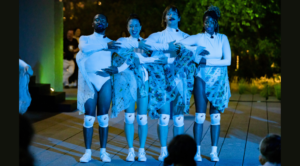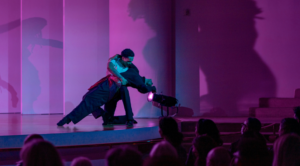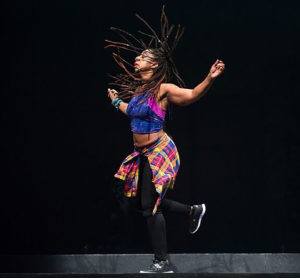Since its inception in 2017, the Pillow Lab has cultivated and nurtured U.S.-based and international dance artists during crucial stages of their artistic processes. The Pillow Lab is a residency program dedicated to the research and development of choreography-driven projects, created in the spirit of residences that have taken place at the Pillow since its beginnings in the early 1930s. During Festival 2024, Pillow audiences will have the unique opportunity to see the innovative work generated in past residencies by six Pillow Lab artists.
Read below to learn more about these six artists, and how their Pillow Labs informed the work coming to the Festival this summer.
Theresa Ruth Howard | MoBBallet: Creating Pathways to Performance
Henry J. Leir Stage, July 10-11, 6pm
In March 2023 and 2024, Memoirs of Blacks in Ballet (MoBBallet) founder Theresa Ruth Howard gathered dancers and choreographers in the Pillow Lab for the Pathways to Performance (PTP) Choreographic Program, an exciting new project by MoBBallet created to nurture and develop Black ballet choreographers.
“My puzzle is, not having a company, [to] figure out the way to pull dancers together to allow choreographers to work on them,” said Howard at the in-process showing held at the end of the 10-day Pillow Lab residency in 2023.
Howard remarked that none of the dancers had been to the Pillow before, and she had the “pleasure of introducing [the dancers] to the Pillow when it’s quiet and it’s theirs.” Choreographer Christopher Huggins returned to the Pillow for the first time since 1982, when he performed as a dancer with the Danny Sloan Dance Company. Dancers in the Lab with Huggins described the artistic process as “very collaborative.”
This summer on the Leir Stage, MoBBallet and the PTP Choreographic Program will return to the Pillow with an evening of works by five Black choreographers, including new works created in the Pillow Lab. Featuring newly-commissioned and previous works, “MoBBallet: Creating Pathways to Performance” will offer a glimpse into an enriched creative process where all voices are valued and embraced.

Miguel Gutierrez
Henry J. Leir Stage, July 17, 6pm
Multi-disciplinary artist Miguel Gutierrez will have a Pillow Lab residency this July. In his residency, Gutierrez will focus on cultivating two projects: sueño, a music and dance project to be performed on the Leir Stage during the residency, and a new project titled Super Nothing.
Integral to sueño was a dive into the Pillow’s historic Archives, drawing upon work by Ted Shawn, the founder of Jacob’s Pillow, among early-twentieth century modern dance pioneers Harald Kreuzberg and Isadora Duncan.
“When I looked at those early modern dances, I was struck by how sincere the approach was to actions that read as quite campy now,” said Gutierrez. “I think this balance of self-awareness and sincerity intrigues me because dance as an artistic project is always about believing deeply in something that is kind of absurd.”
For his second project, Super Nothing, Gutierrez will turn inward to his own personal archive to meditate on what choreography means to him in the present moment. This represents a divergence from his typical process, in which Gutierrez would attempt to “forget what I’ve made before and how I’ve made it.”
For audiences coming to the Pillow this summer, Gutierrez hopes that audiences “always come with an open heart,” ready to engage with the feelings stirring within the hearts of people both on and off the stage.
Christal Brown | INSPIRIT
Henry J. Leir Stage, July 19, 6pm
Since its creation in 2004 by Artistic Director, artist, and educator Christal Brown, INSPIRIT has evolved from a dance company into a collaborative methodology that makes dances which embody unity and communal growth. In the company’s March 2021 Pillow Lab, Brown cultivated her newest project, What We Ask of Flesh, bringing together five years of movement research.
“We’re really fortunate to bring the company here to try and synthesize these five years of research into an experience that epitomizes the human capacity for life,” said Brown in an interview during the residency.
In the residency, Brown discovered that interdisciplinary collaborators were “essential to the process” in navigating What We Ask of Flesh. Composer, videographer, and musician Farai Malianga echoed this sentiment.
“I feel that I’m actually immersing myself, and connecting, and taking care of as many of the different voices as possible,” said Malianga, “with the same contribution, from different angles.”
Other members of the residency highlighted the feelings of community that developed while in the Lab. Brown’s son, Gabe, said that “Jacob’s Pillow is really more like a temporary home. It’s like a bowl, it’s tilted all of us towards the center and towards each other.”
What We Ask of Flesh premiered in November 2023 at Middlebury College as a work which combines soundscapes, installation art, and the dancers’ physicality to explore the stories carried within our own bodies. At the Pillow this summer, INSPIRIT will perform an “organic” rendition of the work on the outdoor stage.

Sekou McMiller | Sekou McMiller & Friends
Henry J. Leir Stage, July 25, 6pm
Sekou McMiller, a New York City/Chicago-based choreographer, teacher, curator, and producer, expanded his series “Afro-Latin Jazz and Soul Experience” in his residency this past October and November. In the residency, McMiller centered his research on an aspect of Afro-Latin social dance called “shines,” a footwork and/or body movement sequence that breaks away from the traditional partnership structure to show individual expression. The choreographer and director has focused on delving into the origins of the “shine.”
“We’re doing an investigation,” said McMiller, “… What is the impulse? Where is that coming from? What are we doing in that moment? How does it make you feel?”
In the Pillow Lab, the dancers used these questions as jumping off points to look into their own “shine.” Dancer Desiree Godswell said that McMiller often told the dancers in rehearsal to “live your life.”
“For me to live my life as a dancer is for me to be present and fully committed to who I am and bring myself to the dance…” said Godswell, “[Sekou’s] saying that of everybody.”
McMiller was also interested in investigating the transition of Afro-Latin social dance from its traditional setting, on the dance floor, to the proscenium stage. In this process, McMiller found a similarity between the relationship of “shines” to the partner dance structure, and improvisation to choreographic structure. This unique relationship will be seen on the Leir Stage this summer, with the presentation of “Afro Latin Soul” by Sekou McMiller & Friends, featuring live music.
“To maintain the true essence of shines within the dance while moving onto the proscenium stage is, in a way, to promote and encourage individual expression…” said McMiller, “When you let go and shine, you can be free.”
Emma Cianchi
Henry J. Leir Stage, July 31, 6pm
Naples-based Emma Cianchi journeyed to the Pillow in March and April 2022 for a Pillow Lab residency as a part of a broader project to cultivate artistic connections across oceans and different cultures. A collaboration between American Dance Abroad and Woman Made, an initiative focused on international women choreographers and an offshoot of Boarding Pass Plus ‘21/’22 of the Italian Ministry of Culture, Cianchi brought together two dancers from Italy and three dancers from the U.S. for this special project.
In the Pillow Lab, Cianchi developed her work Il mare che ci unisce (translation: the sea that unites us), exploring the connections and friendships that unite people across time and space. Cianchi was inspired by long-distance friendships, as well as the ancestral images and figures of the Mediterranean land.
Despite the dancers’ speaking different native languages, the physicality of movement allowed them to continue to form connections. Italian dancer Maria Anzivino said that although the difficulty of language was an “objective gap,” the dancers always found a way “to communicate anyway.”
Cianchi will present Il mare che ci unisce on the outdoor Leir Stage in this summer’s Festival. Anzivino, one of the dancers in the Pillow Lab during the core development of the work, will be dancing among four others. When engaging with Il mare che ci unisce, Cianchi urges audiences to become enchanted by the ancient history and sounds of the Mediterranean world, and “surrender to the emotions” of the bonds formed despite distances.
Camille A. Brown | Camille A. Brown & Dancers
Ted Shawn Theatre, July 31-August 4 Wed., Thurs., and Sat. at 8 pm, Fri.-Sun. at 2pm
In the Ted Shawn Theatre this upcoming July, Camille A. Brown & Dancers will present the world premiere of I AM, a work developed in part during the award-winning choreographer’s January 2023 Pillow Lab residency.

In the residency, company members were challenged to explore their artistry at a deeper level, and “not just through movement, but intellectually.” The value of authenticity and individuality speaks to the “spectrum of Blackness” in Brown’s work, pulling on the different backgrounds of the company artists and utilizing different forms of movement.
“It’s thrilling to work in that way because you feel that you are valued not just as a dancer, but as an artist, as a person, as an individual,” said company member Mayte Natalio.
In I AM, Brown picked up right where she left off in her last company work, ink, which ended with the dancers in flight, lifting up and “into the future.” Brown was inspired by superheroes, and used gestural languages of the African diaspora to create the idea of the company remaining steadfast in their rise.
“It makes sense that I was thinking about superheroes,” said Brown. “It wasn’t about the capes, it was about the idea that in the midst of oppression, Black people still keep rising.”